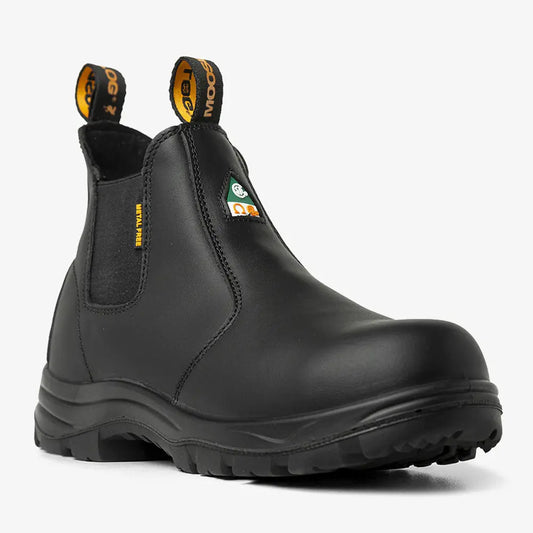
Puncture-Resistant Plates in Work Boots: With vs Without
Your boots protect you from hazards above, below and around you. Most workers focus on the toe cap because it is the most visible part of a safety boot, but what sits underneath your foot is just as important. A puncture-resistant (PR) plate shields the bottom of your foot from sharp debris that hides in soil, concrete, gravel, scrap piles and renovation waste. Workers who spend their day around nails, rebar, metal offcuts or broken material rely on this layer to avoid injuries that take them off the job.
What Is a Puncture-Resistant Plate?
A puncture-resistant plate is a firm barrier built into the boot under the footbed. It sits between the outsole and the insole and covers the entire area under your foot. Its only job is to stop sharp objects from pushing through the bottom of the boot.
To be considered puncture-resistant, the plate must pass strict tests under safety standards:
- CSA Z195 (Canada)
- ASTM F2413 (USA)
Testing uses a force of up to 1200 N (about 270 pounds) on a pointed test probe. The plate must stop the probe completely with no breakthrough. Boots that pass carry a “PR” marking on the label.
Steel vs Composite Plates
Steel Plate
- Very strong and durable
- Heavier and less flexible
- Transfers heat and cold
- Sets off metal detectors
- Common in older or budget safety boots
Composite Plate
- Made from Kevlar®, aramid fibre or engineered plastics
- Lighter and more flexible
- Does not conduct heat or electricity
- Works well in fast-paced roles or metal-free zones
- Found in many modern boots due to comfort and weight benefits
Both plate types must meet the same CSA and ASTM test results. The difference is the feel and weight, not the level of protection.
Why PR Plates Matter on the Job
Underfoot Protection
Construction debris, demolition waste, pallet nails, broken tile and sharp landscaping tools sit underfoot throughout the day. A PR plate blocks these hazards before they reach the foot.
CSA and ASTM Compliance
Many jobsites require PR-rated boots as part of mandatory PPE. A missing PR rating can result in denied entry or being sent home.
Complete Protection Set
Boots with PR plates often carry impact, compression and electrical hazard features. Workers who move through unpredictable environments depend on this full set of protections.
What Happens Without PR Protection
Rubber outsoles alone cannot stop nails or screws. Without a plate, the risk of puncture injuries increases on any site that handles construction materials, pallets, scrap, or uneven terrain. Workers may feel secure with a strong toe cap, but the underside of the foot remains exposed if the boot has no PR rating.
Some job roles also enforce PPE audits. If a boot does not show a PR marking, you may be required to leave the site until you have certified footwear.
How to Check for PR Protection
Look directly at the tongue label, inside tag or outsole stamping. You should see:
- CSA: “PR” next to “I” (impact), “C” (compression) and “EH” (electrical hazard)
- ASTM: “F2413-18 M I/75 C/75 PR EH”
If “PR” is missing, the boot has no puncture-resistant plate, even if the toe cap is certified.
Who Needs PR Plates Most
| Industry | PR Plate Needed? | Reason |
|---|---|---|
| Construction | Yes | Nails, rebar, debris everywhere |
| Demolition | Yes | High exposure to sharp waste |
| Warehousing | Sometimes | Pallet nails, splinters |
| Electrical/Utility | Often | PR + EH often required |
| Landscaping | Recommended | Spikes, tools, glass |
| Light Duty/Admin | No | Minimal risk |
Workers who move between multiple sites or handle unknown ground conditions gain the most from PR protection.
Comfort and PR Plates
Older steel plates added weight and stiffness, but modern composite plates bend with the foot and reduce fatigue. Most workers do not feel the plate once the boot is broken in. Proper sizing and a supportive insole influence comfort far more than the plate itself.
What This Comes Down To
If the ground you work on can hide a sharp hazard, a PR-rated boot is a practical layer of insurance for your feet. Steel and composite plates both meet the same safety standards. The important factor is certification, durability and readiness for the work you do. For more detail on choosing the right safety footwear across all job types, read our Complete Work Boots Buyer's Guide.






